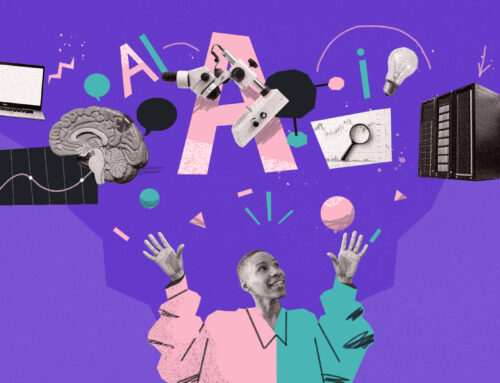Technology has come a long way in optimizing business operations. Not only does it empower the labor workforce, but it also improves customer interactions.
Enter artificial intelligence (AI) and automation, two of the most advanced technologies in today’s business landscape. They can potentially enhance the customer experience for business growth and success.
This page tackles the rise of AI and automation in business. Read on to see how they can transform customer relations in this digital age.
Understanding AI and Automation for Customer Relations
First things first, what is customer relations?
Customer relations is the method used to interact with consumers. How you deal with your potential and regular customers can impact your business. The ultimate goal is to improve customer experience and achieve customer satisfaction (CSAT) for business profitability, growth, and success.
Technology plays a crucial part in optimizing your customer relations approach. It can improve your company’s accuracy, quality, efficiency, productivity, and CSAT. That’s where AI and automation stand out among other emerging and rising technologies.
Here’s what you need to know about AI and automation:
- Artificial Intelligence: AI has the simulation of intelligence in digital tools and technologies. As such, these machines can somehow think and work like humans. See AI-powered chatbots, IVR systems, and generative AI like ChatGPT? The worldwide AI market could reach $305.90 billion in 2024 and $738.80 billion by 2030 at a compound annual growth rate (CAGR) of 15.83%.

- Automation: Automation uses digital tools and technologies to perform tasks with minimal input. Automated software applications can accelerate processes, remove manual work, and increase overall productivity. Acumen and Research Consulting predicts the global automation software market could grow from $19.9 billion in 2021 to $76.4 Billion by 2030 at a 16.5% CAGR.
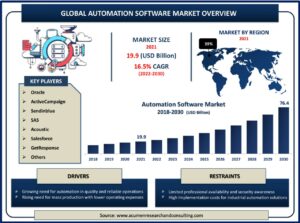
In the next section, learn how AI and automation can positively impact customer relations.
The Impact of AI and Automation on Customer Relations
When it comes to customer relations, AI and automation can do so much. These technologies prove beneficial to the customer experience in more ways than one.
Take it from Deloitte: the top three potential benefits of intelligent automation adoption are increased productivity (73%), cost reduction (60%), and improved accuracy (44%).
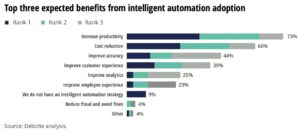
Unconvinced? Here’s how AI and automation can prove beneficial to your customer relations:
- Data-driven customer insights: AI includes machine learning capable of forecasting data based on patterns or trends. Meanwhile, automation not only records but also sorts data. These technologies can provide valuable insights into your customers for informed decision-making.
- Efficient customer support: AI assistants can offer 24/7 customer support when human agents rest after working hours. On the other hand, automation can speed up your tasks and processes. They help provide customers with prompt services without any delays.
- Excellent customer service: Virtual assistants, AI-powered chatbots, and self-service options can be a great addition to your customer service representatives (CSRs). On the contrary, automation can empower your human agents to assist your customers better. These technologies can improve your customer service.
- Streamlined customer journey: AI can guide your prospects and customers in their journey, from providing product recommendations to processing their orders. Meanwhile, automation can accelerate various stages in the sales funnel, from awareness and education to negotiation and sales.
- Improved customer satisfaction: As cited, AI and automation can help improve your customer interactions and enhance their experience. They can boost your service efficiency and product quality. Using automation can give you a 10 to 20% improvement in CSAT scores.
- Guaranteed customer loyalty: Your customer relations determine your customer loyalty. They will continue to support your business and buy your products or hire services if you provide them with an excellent experience. Leveraging AI and automation can help you in this aspect!
- Increased business profitability: Customer relations equates to business profits. With excellent customer experience, they will patronize your brand and buy your products or avail of your services. Using AI and automation can go as far as boosting your sales revenue, much like how preparing with Microsoft AZ-900: Practice Test Dumps can help you master cloud fundamentals and optimize business operations.
- Business scalability and growth: Your business exists because of your customers. Investing in customer relations through the help of modern technologies is key to ensuring your company thrives and survives. Ultimately, AI and automation can be instrumental to your scalability and growth.
In the next section, learn how to leverage AI and automation to improve your customer relations.
How To Optimize Your Customer Relations Using AI and Automation?
Artificial intelligence and automation have become a game-changer in business. Companies and organizations do not only leverage these technologies but combine them for scalability. The same Deloitte report cites that nearly half (about 45% of businesses) combine AI and robotic process automation (RPA).
Specifically, you can use AI and RPA combined for your customer relations. You can capitalize on this combined technology to tackle several functions with customer interactions like:
- Sales outreach
- Digital marketing
- Customer service
- Self-service portals
- Order fulfillment
That said, here’s how to optimize your customer relations using AI and RPA:
Artificial Intelligence
According to Gartner, 80% of business leaders use AI technology for business strategies and decisions.
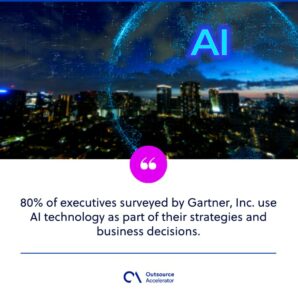
Let’s look at how you can tap into AI to streamline your customer relations specifically.
1. Use predictive analytics to create a customer persona
Predictive analytics is a machine learning (ML), a subset of AI. This technology can learn from datasets and make predictions based on patterns. These data insights can help you make sound business decisions.
Specifically, you can use this analytics tool to develop your customer persona—an ideal representation of your target market. That way, you’ll only reach out to the right consumers and understand them before doing outreach.
Robert Kaskel, Chief People Officer at Checkr, suggests analyzing your target consumers using predictive analytics.
Kaskel explains, “This analytics tool helps you identify your potential customers based on their demographics, psychographics, and other key factors. More importantly, it aids you in understanding their pain points, challenges, goals, and motivations. That way, you can contact them with their best interests in mind.”
2. Enable voice recognition systems for customer interactions
Did you know that voice recognition systems are powered by artificial intelligence? That’s why they are capable of answering questions and processing requests.
Take the interactive voice response (IVR) technology as an example. Customers don’t have to speak with live agents to address some of their concerns. They can interact with the IVR system to get answers to simple inquiries and even place order requests. With the recent AI buzz, key industry players can unlock the potential of Google Bard for voice technology.
As such, companies can further leverage human-like AI technologies to handle complex customer concerns. Currently, they can only handle simple queries and escalate complicated issues to human agents for resolution. However, expect AI to take this customer interaction to the next level.
3. Utilize AI-powered chatbots for 24/7 customer support
AI-integrated chatbots have been all the rage in today’s digital landscape. See those digital bots appearing on your screen when visiting any websites?
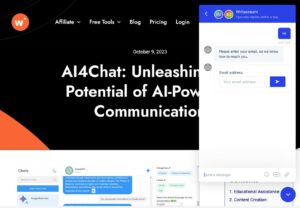
These amazing chatbots can chat with customers like live agents. They can answer commonly asked questions, process basic requests, and address specific concerns related to your products or services. Most importantly, they can provide customer support around the clock.
AI-powered chatbots have so much potential. That’s why they show no signs of stopping or slowing down.
With the recent AI developments like using ChatGPT as an AI assistant, businesses can expect these chatbots to be more responsive, conversational, and human-like. Leverage them as early as now, but keep up with the evolving trends.
4. Employ generative AI for content creation in marketing
Generative AI is another type of AI technology. As the name suggests, it’s capable of generating text, imagery, audio, and synthetic data.
ChatGPT is a perfect example of generative AI for creating content like blog posts, social media captions, and more. DALL-E, an AI-generated art model, can generate striking images on demand. Other models can generate codes and produce audio and video clips.
That said, you can unleash the potential of AI-powered communication for content creation in marketing.
Content is king in the digital world as it has the power to engage with customers. Generative AI makes it easier and faster for you to create pieces of content. It helps you create something that resonates with your target audiences as part of your marketing strategies.
5. Leverage machine learning to forecast customer requests
As mentioned, machine learning is a subcategory of AI technology. But what sets ML apart from other technologies is that it can learn from data patterns without human intervention.
That said, you can leverage ML technology to forecast your customer requests. In customer service, for example, this technology will help you predict the volume of calls, emails, or chat messages you’ll receive in a day. That way, you can cater to your customers and meet their needs.
Jim Pendergast, Senior Vice President at altLINE Sobanco, recommends ML for business forecasting and reporting.
Pendergast explains, “Data analytics powered by AI or ML can help you predict customer interactions and business activities. They can assist in generating reports and making wise business decisions around enhancing the customer experience.”
Automation
According to Hiver, over 25% of professionals value AI for handling routine tasks, while 22% appreciate it for predicting customer needs.
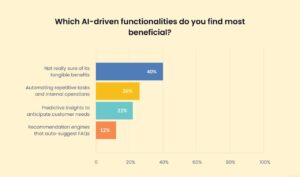
Let’s see how you can employ automation to optimize your customer relations.
6. Automate email campaigns to personalize outreach
Customer interactions begin as early as outreach, which can make or break your sales or business opportunities. What better way to proceed with your email campaign than personalizing your outreach?
Don’t worry; Some of the best cold email generators are readily available, helping you reach out to your leads or prospects.
What’s good is that automation lets you automate several outreach functions, such as email segmentation, personalization, sequencing, and scheduling. It even enables you to send automatic replies or email follow-ups. Not only do they become more efficient, but these emails become more targeted and personalized.
Ultimately, automation allows you to optimize your email campaigns, helping you create personalized content that truly resonates with your target market.
7. Use automation to empower CSRs for customer interactions
In this context, automation is meant to augment the customer experience. But first things first, this technology can empower your employees. This empowerment later extends to your much-valued customers.
For example, your CSRs can be more efficient and effective in a contact center. How? You can leverage computer telephony integration (CTI) technology with automation features like automated pop screens, automatic dialing, and intelligent routing. These features can help your agents serve your customers even better.
Volodymyr Shchegel, VP of Engineering at Clario, highlights the value of RPA technology for employee empowerment and customer satisfaction.
Shchegel argues, “There’s a need to empower your employees with some of the best technologies today, like RPA. These tools can help unburden your agents’ workloads so they can focus on serving your customers. Ultimately, take care of your employees first so they will take good care of your customers.”
8. Offer customers with self-service portals and knowledge base
Customers don’t necessarily have to engage with your employees for various concerns. What better way to give them the best experience than to offer them self-service options?
As such, using automation allows you to provide customers with self-service portals and knowledge. For instance, clients can use the automated IVR system to place orders or pay their bills. You can also develop a comprehensive knowledge base center that customers can access to get answers to frequently asked questions (FAQs). Additionally, implementing simple employee scheduling software ensures that your team is always available to address complex queries that automation cannot handle. Such tools streamline staff availability, reduce scheduling conflicts, and improve overall response times, enhancing both employee efficiency and customer satisfaction.
Jerry Han, CMO at PrizeRebel, underscores the importance of automated self-service options for customer empowerment.
Han explains, “In business, it’s not just about serving your customers the best way possible. It’s also about empowering them. One way to do so is to provide customers with self-service options that allow them to find quick solutions to their problems. That’s where automation can help.”
9. Streamline customer journey using automated multichannel solutions
The customer journey starts with awareness and education and ends with negotiation and closing deals. However, they now go through different communication channels via your website, phone, email, live chat, or social media.
To ease out the complexity, leverage automation to streamline your customer journey. For example, you can automate answers to FAQs for email, chat, and social media interactions. You can also use LinkedIn outreach personalization tools to reach out to leads and prospects via the platform.
Further, employ automation in various website functions like order placements, payment options, and checkout processes. They make your customers’ lives a lot easier and more convenient. Even the automated features in inbound and outbound calls can help your customer interactions.
10. Automate order processing and fulfillment functions
In retail and e-commerce, order fulfillment is one of the most important functions for business profitability. You should make this process efficient and seamless to avoid delays and guarantee customer satisfaction.
Automation can streamline your order processing and fulfillment functions. For example, this technology helps your back-office team process orders, coordinate with other departments, and monitor product delivery more efficiently and seamlessly. Likewise, it allows customers to track their requests soon after their order placement online.
Puneet Gogia, Founder of Excel Champs, recommends using automation for order fulfillment.
Gogia says, “You can incorporate automation into your manual Excel for order processing, tracking, and fulfillment. Airtable is a perfect example of automation with a spreadsheet and database rolled into one. It allows you to do the work faster and easier, making customers delighted when their packages arrive at their doorsteps on time.”
Final Words
There’s no denying the impact of technology in today’s business landscape. The use of AI and automation can help streamline your business operations. Not only does it aid your employees, but it benefits the customers through robust interactions.
That said, leverage AI and automation to optimize your customer relations. Consider our recommendations above using AI tools, such as predictive analytics, chatbots, voice recognition, and ML, as well as automated applications for email campaigns, knowledge bases, multichannel solutions, and order fulfillment.
Harness the power of AI and automation, and you can ultimately transform your customer relations for the better!

